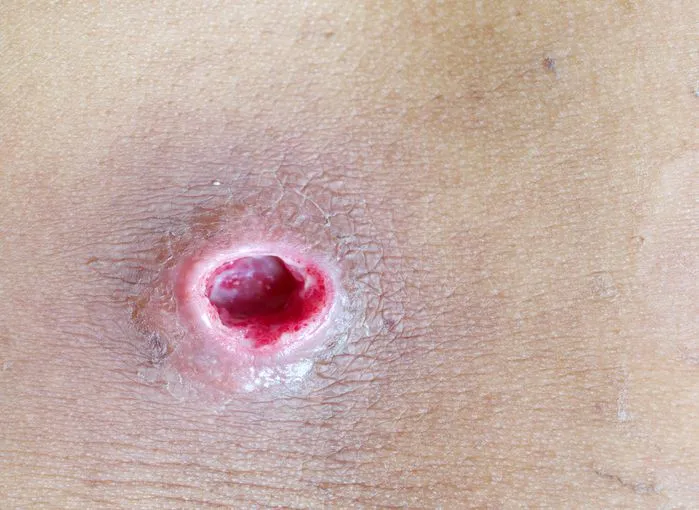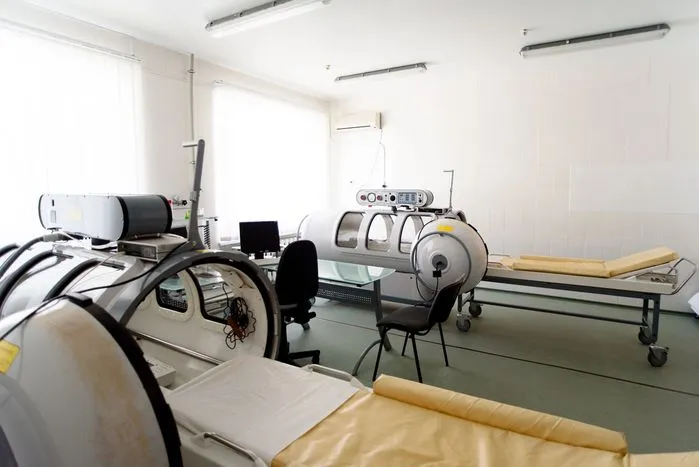What's an abscess? Picture it as a tender packet of pus, like a gathering of unwanted bacteria shielded by inflamed tissue. Quite the image, right?
Unlike the fiery abscess, cysts are benign pockets of tissue that contain fluid, pus, or other materials.
Boils are painful pus-filled lumps that form when bacteria infect your hair follicles.
Remember that all of them have unique causes and require specialized treatments.
Key Takeaways
- Tender, pus-filled masses known as abscesses result from infection, necessitating drainage alongside antibiotics for successful treatment.
- Different from abscesses, benign pockets of tissue, referred to as cysts, aren't usually an infection outcome.
- Bacterial infection in hair follicles leads to painful, pus-filled lumps, or boils. Good hygiene often proves beneficial in their prevention.
- Significant differences exist among these conditions. Boils and abscesses typically cause pain and display infection signs, whereas cysts develop slowly, often without causing discomfort.
- In terms of treatment, warm compresses can soothe boils, along with cysts. Surgical intervention may be necessary in severe cases of all these conditions.
Understanding Skin Abscesses
They usually appear surrounded by a colored inflamed area. Their formation results from complex processes starting with dead tissue, bacteria, and white blood cell accumulation, leading to a thick fluid buildup - the first sign of an abscess.
Management of skin abscesses requires careful attention, particularly to abscess drainage. Draining accumulated pus and fluid is critical to prevent infection spread and promote healing. Antibiotics are also useful in controlling the infection, but they cannot replace effective drainage.
The Nature of Cysts
Cysts typically present as benign, sealed pockets of tissue, often filled with fluid, pus, or other material. These skin conditions may appear similar to abscesses. However, infections do not typically cause them, and they grow in various bodily regions. Diverse reasons, such as genetic conditions, diseases, or obstructions in natural ducts, cause cysts.
Numerous cyst types exist, like sebaceous cysts originating from the skin's sebaceous glands, and ovarian cysts.
Boils: A Closer Look
Unlike the others, they are extremely painful, filled with pus, and form beneath your skin due to bacterial infection and inflammation of one or more hair follicles, a process termed boil formation. They initially appear as red, tender lumps, gradually turning firm, hard, and increasingly painful. Finally, these lumps fill up with pus, forming a head that might drain spontaneously or require lancing by a specialist.
Immediate cleaning of cuts, abrasions, or any skin breakage, along with the use of over-the-counter antibiotic ointment, prevents bacteria from invading and causing an infection.
Comparing Symptoms and Causes
Painful, pus-filled lumps characterize boils, while cysts and abscesses display a variety of symptoms.
Notably, boils often exhibit redness and swelling, with pus visible at the top. In contrast, cysts primarily appear as slow-growing lumps under the skin, typically without pain.
Abscesses, combining traits of both, cause pain, swelling, and possibly contain pus.
"Abscesses, cysts, and boils may appear similar, but their differences are key to understanding proper care. While abscesses are painful, pus-filled masses caused by infection, cysts are benign, slow-growing pockets often free from pain. Boils, on the other hand, are inflamed lumps resulting from hair follicle infections. Each condition demands tailored treatment—ranging from warm compresses to surgical interventions—highlighting the importance of proper diagnosis and timely care for optimal skin health."
Treatment Options for Each Condition
Treatment options depend on condition severity along with the patient's health status. Home remedies often work well for less severe cases. Warm compresses, for example, can soothe boils and cysts. Over-the-counter creams are beneficial for abscesses. Resistance exercises sometimes reduce cyst size and discomfort. However, these methods don't always work, necessitating a visit to a specialist.
Physicians may opt for procedures like incisions, drainage, or surgical removal in severe cases. Commonly, antibiotics are prescribed to treat and prevent infection spread. Surgical drainage generally is the norm for abscess treatment.
Supporting Facts and Statistics
According to the Centers for Disease Control and Prevention (CDC), most skin health problems are caused by Staphylococcus aureus. It is a bacteria found in specific areas like the nose and skin. Cases and hospital admissions rose from 2003 to 20024.
CDC research indicates that hospital admissions for skin and soft tissue infections increased significantly during the early 2000s. This rise is attributed to the emergence of community-associated MRSA infections, underscoring the growing public health concern.
The Centers for Disease Control and Prevention (CDC) recommends incision and drainage as the primary treatment for uncomplicated skin abscesses. Antibiotic therapy is advised in cases with severe infection, rapid progression, or systemic illness.
The Wound Pros’ Opinion on The Differences of Abscesses, Cysts, and Boils
Abscesses, cysts, and boils signify diverse skin conditions, each possessing unique causes, symptoms, and treatments. At TheWoundPros.com, we believe that comprehending these distinctions is crucial for comprehensive diagnosis, and successful treatment. Bacterial infections typically result in abscesses, blocked ducts, or glands causing cysts, while staph bacteria give rise to boils. Treatments vary from antibiotics to surgical interventions. We support that these diseases aid in prompt detection, and successful treatment, thereby reducing complications, and fostering skin well-being.
Frequently Asked Questions
How do I know if I have a cyst or an abscess?
You can determine if you have a cyst or an abscess by observing symptoms such as redness, swelling, and pain. Generally, an abscess is more painful and causes fever due to infection, while a cyst may not cause any discomfort.
Will an abscess go away untreated?
An abscess will not typically go away untreated. It might become larger and more painful over time. It might also burst, spreading the infection, which can lead to serious health issues. Therefore, it is important to seek medical attention if you suspect you have an abscess.
Will urgent care drain a cyst?
Urgent care facilities can drain a cyst, but it depends on the size and location of the cyst. They typically drain minor cysts but may refer you to a specialist for larger or more complicated cases.
Can an abscess be cancerous?
Although an abscess itself isn't cancerous, it can be a symptom of underlying diseases, including cancer. Thus, it's important to have any persistent abscess evaluated by a healthcare provider.
Is an abscess lump hard or soft?
An abscess lump is typically soft and tender due to the pus buildup. It may feel warm to the touch and might be surrounded by reddening skin.
How do you get rid of an abscess or cyst?
To get rid of an abscess or cyst, you should seek medical treatment. A healthcare provider may drain it or prescribe antibiotics in the case of an abscess. In some cases, surgical removal may be necessary.
What does an abscess bump look like?
An abscess bump typically looks like a swollen, red, and tender area on your skin. It may also be warm to the touch and can be filled with pus or fluid.
Should you go to the ER for a cyst?
Whether you should go to the ER for a cyst depends on its severity. If a cyst is causing severe pain, has ruptured, or is accompanied by fever, you should seek immediate medical attention.
What do the beginning stages of an abscess look like?
The beginning stages of an abscess may look like a swollen, red area on your skin. You might also experience tenderness and warmth in the affected area.
What draws out a cyst?
Warm compresses can help to draw out a cyst, but it's always best to seek medical advice before attempting any home remedies.
What does an abscess feel like before it bursts?
Before an abscess bursts, it can feel very tender and painful. The skin around it may be red and warm, and you may also experience a general feeling of being unwell.
Is a cyst hard or soft?
A cyst can be either hard or soft, depending on what it's filled with. Some cysts are filled with air or fluid, making them soft, while others are filled with harder material like keratin.




.webp)

.avif)